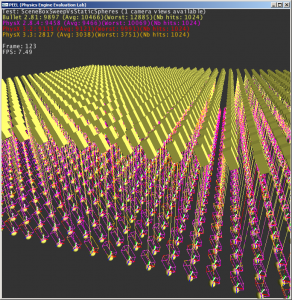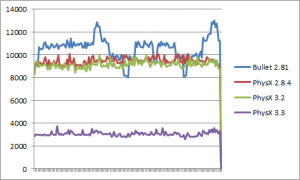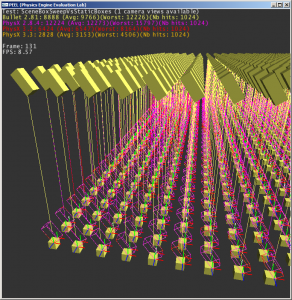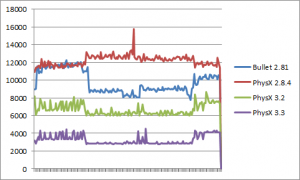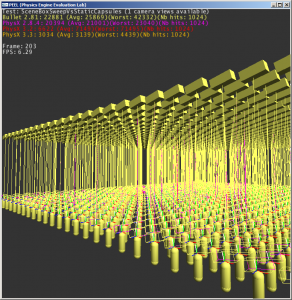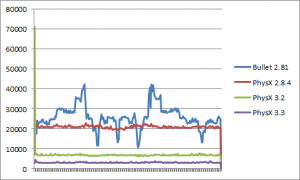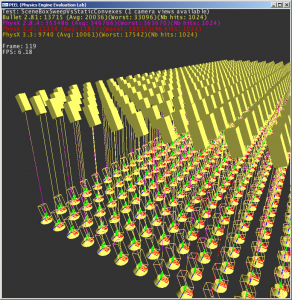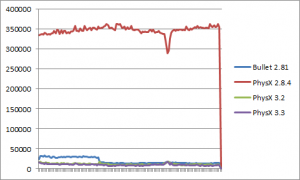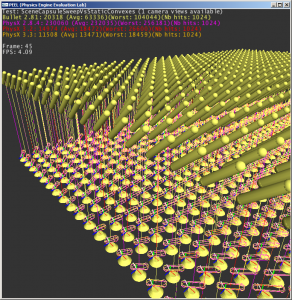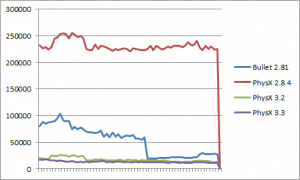The evolution of PhysX (10/12) - Sweep tests
Another important feature is sweep tests, a.k.a. “linear casts” or “shape casts”. This can be used, for example, to implement character controllers. What I previously wrote for raycasts is even more valid for sweeps: a lot of things depend on whether you go for a generic GJK-based sweep, or for dedicated shape-vs-shape sweep functions. And since sweep functions are usually much more difficult to write than raycast functions, this is often the part of physics engines where things sometimes go spectacularly wrong.
There are even more potential things to test here, than for raycasts. Even when you go for customized raycast functions, you get away with N of them (e.g. for N supported shapes you need to write N raycast functions). For sweeps however, you can decide to sweep any shape against any other, so you suddenly need to write N*(N-1)/2 functions, and each of them is a lot harder than just a raycast. This is why most engines just go for a generic GJK-based sweep function, which can be used as-is for all cases. The downside of this is that the generic code, as often, may not be as fast as a customized function.
But enough theory: let’s see what we get. I will only focus on a small set of selected tests, rather than tediously listing the results for all N*(N-1)/2 cases.
—-
Our first scene (“SceneBoxSweepVsStaticSpheres”) uses the same array of spheres as our initial raycast test. But instead of doing a raycast against each of them, we do a box sweep. We are again using the scene-level API functions to do so.
The boxes are slowly rotating over time, to make sure that we hit all codepaths from the sweep functions, and just to make sure that things don’t suddenly break for some angle, for some reason.
The results are a bit different than usual. Each PhysX version is faster than the one before… kind of. This time there isn’t much of a difference between 2.8.4 and 3.2. It looks like 3.2 is a wee bit faster, but frankly that might be just noise at this point.
Bullet looks fine in this test, very similar to PhysX 2.8.4 and 3.2, although slightly slower. The profile curve also isn’t as smooth as for PhysX but overall it’s quite comparable.
The clear winner in this test though, is PhysX 3.3. It is about 3X faster than both Bullet and the previous PhysX versions. Nice.
—-
Let’s stay with box-sweeps, but let’s try against static boxes now (“SceneBoxSweepVsStaticBoxes”).
Things are a bit different this time: Bullet is faster than 2.8.4 is that test. On the other hand it is slower than PhysX 3.x.
Each PhysX version is faster than the one before – checked. In fact, on average, each PhysX version is 2X faster than the one before. That’s quite something!
—-
Ok we did box-sweeps vs spheres and boxes, let’s see what happens against capsules in the next test (“SceneBoxSweepVsStaticCapsules”).
PhysX 3.x is significantly faster than PhysX 2.8.4 – with again each PhysX version being faster than the one before. In terms of relative performance there’s a remarkable 6.7X speedup on average between 2.8.4 and 3.3. Nice.
Bullet has about the same performance as 2.8.4, with again a much more chaotic curve. But PhysX 3.3 is about 8X faster than Bullet on average here.
—-
Now, you guessed it, after spheres, boxes and capsules, and in sake of completeness, let’s have a look at box-sweeps against convex objects (“SceneBoxSweepVsStaticConvexes”).
Wo-ah. Now that is a surprise! See, that’s what I what talking about: sometimes things can go spectacularly wrong with sweeps, and you really need a strong test suite to make sure you catch all those problems.
Clearly the 2.8.4 code had a problem here. I can’t remember what it was, but clearly, if you are still using 2.8.4 and you do a lot of box-sweeps against convexes, you seriously need to upgrade. On average, PhysX 3.3 is 34X faster than 2.8.4 in this case. Now that is some serious speedup.
Other than that, each PhysX version is faster than the one before (good), and contrary to what we saw just in the previous test, Bullet remains quite competitive here, even against PhysX 3.3.
So, that’s sweep tests. You never know until you actually profile.
—-
Now, we could repeat this exercise for sphere-sweeps and capsule-sweeps against all the other shapes as we just did for boxes, but the results are very similar. The only surprise comes again from the capsule-vs-convex case (“SceneCapsuleSweepVsStaticConvexes”).
In short, this is the same as for box-vs-convex: 2.8.4 was pretty bad here. On average, PhysX 3.3 is 17X faster than 2.8.4 in this case.
Bullet’s profile curve is weird. I can’t explain why it suddenly becomes faster towards the end. It is probably related to the fact that the capsules are rotating, and the algorithm may switch from one case to another, but I don’t know the Bullet’s internals enough to tell.
